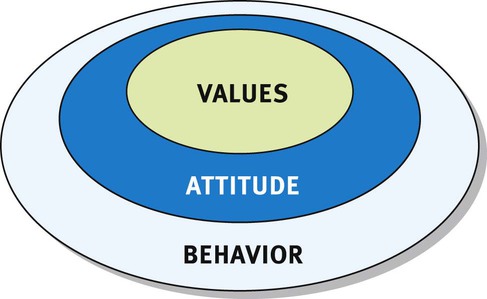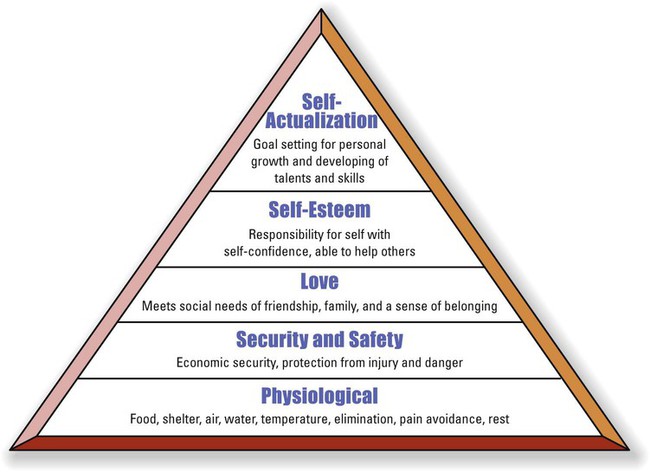Chapter 2 When working with a patient from a different culture, the health care worker should follow guidelines that are sensitive to diverse beliefs (Box 2-1). If an interpreter is necessary, the health care worker watches the patient, not the interpreter, when speaking. The health care worker should avoid the phrases “you must” or “you should” and offer reasonable options instead. Important information is repeated more than once. Attitudes are formed from personal values. Values make up the system each individual uses to measure or evaluate the worth of ideas, people, and things in the world. They are formed early in life as a result of the environment and experience. Values are difficult to change. An undesirable value such as prejudice might not even be recognized by the individual who holds it (Fig. 2-1). The sum of the behavior, attitudes, and values that a person exhibits to others is called character. The patient and other caregivers expect certain characteristics, attitudes, and behaviors in the health care worker (Box 2-2). Undesirable behavior can be changed if it is recognized and the desired behavior is practiced. Erik Erikson describes eight stages of psychosocial development with tasks that must be completed throughout life to develop an identity (Table 2-1). His theory of personality development states that achievement of a task, or crisis, may be complete, partial, or unsuccessful. The more the task is mastered or completed, the healthier the personality of the individual. A favorable resolution of the task is called a “virtue.” Erikson states that the person must find a balance between the parts of a task. For example, a child who can get dressed independently demonstrates a balance between trust and guilt. TABLE 2-1 Good personal health is basic for an individual to establish high self-esteem. The World Health Organization defines health as a state of physical, mental, and social well-being. It is not just the absence of illness or injury. The foundation of good personal health, cleanliness, is maintained by a daily routine that includes bathing, using a deodorant, shampooing the hair, and cleaning the teeth (Table 2-2). Nutrition, exercise, sleep, posture, eye care, and good personal habits are also necessary to maintain good health. Some specific daily behaviors that indicate good personal grooming include the use of mouthwash, shaving, nail care, change of undergarments, and clean clothing that fits properly. Health care workers wear minimal jewelry to prevent both its loss and the spread of microorganisms. TABLE 2-2 Good Grooming Habits for Health Care Workers Health care is one of the most stressful occupations. The work affects the most fundamental part of the patient’s and health care worker’s lives. One of the first psychologists who studied stress-related disease was Claude Bernard. He proposed that the body has an “internal milieu,” or need to maintain a consistent internal environment. Canon used the term homeostasis to describe the self-regulating processes of the body, including the “fight or flight” reaction to stress. Hans Seyle noted that many diseases share similar signs and symptoms, such as fatigue, weight loss, aches, and gastrointestinal problems. He stated that these result from a general stress reaction from increased adrenal gland secretions, shrinkage of lymphatic tissues, and increased secretion of hydrochloric acid in the stomach. Seyle proposed that illness results from too small or too large of a reaction by the body’s stress adaptation mechanism (Table 2-3). TABLE 2-3 Some methods used to manage stress include proper nutrition, exercise, relaxation techniques, and personal behavior changes (Box 2-3). Stress is not the result of events that occur, but rather it is the result of attitudes that are formed about the events. Another stress management technique includes a method of time management. Setting both short-term and long-term goals increases the probability of accomplishing them. Goals allow a person to establish step-by-step actions toward accomplishing something. Keeping focused on the goal helps one to complete the action steps necessary to reach it. Reaching a goal creates pride and self-confidence. Goals should be clearly defined, measurable, and tangible (Box 2-4).
Interpersonal Dynamics and Communications
 Define at least 10 words relating to the health care worker’s characteristics and abilities.
Define at least 10 words relating to the health care worker’s characteristics and abilities.
 Describe the relationship among values, attitudes, and behavior.
Describe the relationship among values, attitudes, and behavior.
 Describe the hierarchy of needs established by Abraham Maslow.
Describe the hierarchy of needs established by Abraham Maslow.
 Identify at least five methods of maintaining good personal health and professional appearance.
Identify at least five methods of maintaining good personal health and professional appearance.
 Use a problem-solving system to make a decision that involves identification of alternatives, risks, and evaluation of the outcome.
Use a problem-solving system to make a decision that involves identification of alternatives, risks, and evaluation of the outcome.
 Identify the elements of effective communication and at least three factors that might interfere with it.
Identify the elements of effective communication and at least three factors that might interfere with it.
 Describe at least one example of assertive communication that requests a change in behavior.
Describe at least one example of assertive communication that requests a change in behavior.
Interpersonal Dynamics
Self-Awareness
Task Achievement
Psychosocial Stage
Virtue
Conflict
Infant
Hope
Trust vs. mistrust
Toddler
Will
Autonomy vs. shame and doubt
Kindergarten
Purpose
Initiative vs. guilt
Age 6 yr to puberty
Competence
Industry vs. inferiority
Teenager
Fidelity
Identity vs. role confusion
Young adult
Love
Intimacy vs. isolation
Midlife
Caring
Generativity vs. stagnation
Old age
Wisdom
Ego integrity vs. despair
Personal Health
Habit
Action
Oral hygiene
Brush at least twice daily, and use mouthwash once daily
Hair care
Shampoo regularly, style hair away from the face and off the collar
Skin care
Cleanse regularly; treat rashes, blemishes
Wear nylons or socks to prevent skin shedding (exfoliation)
Use clear to no polish
Use antiperspirant, no perfume
Nail care
Clean nails, trim close to fingertips
Use clear or no polish
Clothing
Appropriate, modest
Clean, pressed, well-fitting
Mended, comfortable, allowing movement
Undergarments changed daily, well-fitted, not visible through clothing
Minimal or no jewelry
Name pin and watch in place
Foot care
Socks or stockings clean daily
Toenails trimmed regularly
Shoes cleaned and polished
Shoes sturdy, nonskid, low-heeled with closed toes
Stress and Time Management
Body Process
Effect of Stress
Cardiovascular system
Heart attack (myocardial infarction)
High blood pressure (hypertension)
Heart pain (angina)
Migraine headache
Stroke (cerebrovascular accident)
Digestive system
Ulcer
Colitis
Constipation, diarrhea
Skeletal system
Arthritis
Muscular system
Headache
Backache
Respiratory system
Asthma
Endocrine system
Diabetes (Type II)
Nervous system
Accident proneness (decreased attention)
Immune process
Increased rate of infection
Allergies
Autoimmune disorders
Psychosocial process
Fighting and conflicts
Alcoholism and drug abuse

















































